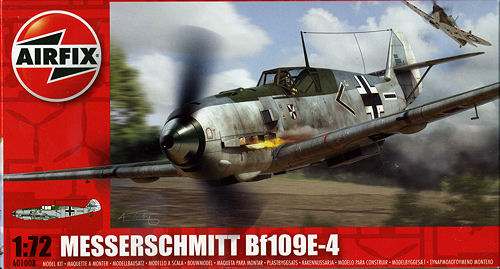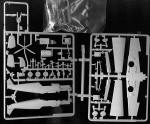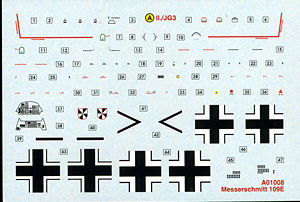
Airfix 1/72 Bf-109E-4
| KIT #: | A01008 |
| PRICE: | $7.25 SRP |
| DECALS: | One option |
| REVIEWER: | Scott Van Aken |
| NOTES: | New tool kit |

| HISTORY |
The Bf-109E-3 was the most widely built of the 'square wing' versions, but was replaced by the E-4 (with many E-3 airframes being upgraded to E-4 standards starting at the beginning of the Battle of Britain) which was different in some small details, most notably by using the modified 20 mm MG-FF/M wing cannon and having improved head armor for the pilot. With the MG FF/M it was possible to fire a new and improved type of explosive shell, called Minengescho▀ (or 'mine-shell') which was made using drawn steel (the same way brass cartridges are made) instead of being cast as was the usual practice. This resulted in a shell with a thin but strong wall, which had a larger cavity in which to pack a much larger explosive charge than was otherwise possible. The new shell required modifications to the MG FF's mechanism due to the different recoil characteristics, hence the MG FF/M designation.
The cockpit canopy was also revised to an easier-to-produce, "squared-off" design, which also helped improve the pilot's field of view. This canopy, which was also retrofitted to many E-1s and E-3s, was largely unchanged until the introduction of a welded, heavy-framed canopy on the G series in the autumn of 1942. The E-4 would be the basis for all further Bf 109E developments. Some E-4 and later models received a further improved 1,175 PS (1,159 hp, 864 kW) DB601N high-altitude engine; known as the E-4/N this first appeared in July 1940. The E-4 was also available as a fighter-bomber with equipment very similar to the previous E-1/B. It was known as E-4/B (DB 601Aa engine) and E-4/BN (DB 601N engine). A total of 561 of all E-4 versions were built, including 250 E-4, 20 E-4/N, 211 E-4/B and 15 E-4/BN. Many E-4s were retrofitted with the E-7's major improvement; a long range drop tank, starting in October of 1940.
| THE KIT |
 You
would think that there would be enough Bf-109Es on the market, but we all know
that is not really the case. This is an all new tool 1/72 kit designed to
replace the older molding and looking very much like their 1/48 release.
You
would think that there would be enough Bf-109Es on the market, but we all know
that is not really the case. This is an all new tool 1/72 kit designed to
replace the older molding and looking very much like their 1/48 release.
I should mention right off that the engraved panel lines seem to be more subdued than in earlier 1/72 releases, so that should please those who did not like the earlier ones. I also notice that this is made in India. It seems Hornby is fed up with the B.S. that is part of dealing with the Chinese and is going with a more reliable source.
The kit has an engine block of sorts molded in with the fuselage halves, like you will find with the Tamiya kit. This includes a lower engine section and separate lower cowling. The interior is very much like the bigger scale kit with separate rudder pedals, sidewall detail and harness detail on the seat. There is also a pilot if you wish one.
The kit also has separate flaps that can be modeled in the down position and Airfix has included the aileron mass balances that were missing from their Bf-110 kits. Also separate is the rudder, which you could place at an angle as the leading edge of the rudder is rounded. The canopy can be built in the open position and the three piece construct is quite clear with well defined frames. Typical of Airfix kits, the gear can be built up, though no stand is included. Both the main wheels and tail wheel have a flat spot on them.
What you do not get with this is any way to model any
other aircraft other than a Battle of Britain 109E-4. There is no drop tank or
rack and no sand filter as used in North Africa. You also get just one spinner
so cannot d o
an E-7. I am going to assume that these will be other boxings as there are areas
on the sprues that could easily hold these parts.
o
an E-7. I am going to assume that these will be other boxings as there are areas
on the sprues that could easily hold these parts.
Instructions are well done using only Humbrol paint numbers for references. You already know how I feel about this. Markings are for a single aircraft as flown by Franz von Werra during August 1940 with II./JG 3. The aircraft is in RLM 71/02/65 with white bits on the rudder and wing tip. The nose is a lighter blue, perhaps something like RLM 76, though the instructions would have you mix white with the RLM 65 underside color. No mottling on this so it will be one that brush painters will like. No swastika either so you will need to rob your spares bin for a historically accurate finish. I should mention that the instrument panel is a decal, which is pretty much the norm for this scale.
| CONCLUSIONS |
109 and Airfix fans will be pleased with this one. I am sure there is some niggling error in it somewhere, but for such a low price, I think that is acceptable. Those tired of forking over $20 plus for the Tamiya kit now have a much less pricey alternative.
| REFERENCES |
http://en.wikipedia.org/wiki/Messerschmitt_Bf_109_variants
June 2012
Thanks to me for buying this one so you can see what it is like.
If you would like your product reviewed fairly and fairly quickly, please contact the editor or see other details in the Note to Contributors.